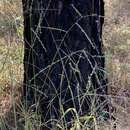Comprehensive Description
provided by North American Flora
Paspalum bifidum (Bertol.) Nash, Bull. Torrey
Club 24 : 192. 1897.
Panicum floridanum Trin. M^m. Acad. St. Petersb. VI. S'-^ : 248. 1834. Not Paspalum flori-
danum. Michx. 1803. Panicum bifidum Bertol. Mem. Accad. Bologna 2 : 598. 1850. Panicum alabamense Trin.; Steud. Syn. Gram. 64. 1854. Paspalum racemulosum Nutt.; Chapm. Fl. S. U. S. 571. 1860. Paspalum interruptum Wood, Class Book ed. 1861. 783. 1861. Paspalum racemosum Beal, Grasses N. Am. 2 : 87. 1896. Not P. racemosum I,am. 1791.
A glaucous perennial with stout scaly rootstocks, the scales appressed-hirsute, flat leafblades, and glabrous spikelets. Stems 7-13 dm. tall, single; leaves mostly at the base of the stem; sheaths, at least the external basal ones, papillose-hirsute; blades 3 dm. long or less, generally 5-10 mm. wide, narrowed at both ends, glabrous or but sparingly hirsute beneath, strongly hirsute above toward the base; racemes usually 2 or 3, sometimes more or only 1, 7-15 cm. long, erect, the rachis triangular, slender, the lateral margins not winged; spikelets in rather distant pairs, oval, 3.5-4 mm. long and about 2.5 mm. wide, the first scale wanting, or sometimes present but small or rudimentary, the second scale 7-nerved, the third scale 5-nerved, the fruiting scale yellowish, minutely roughened.
Type locality : Alabama.
Distribution : South Carolina to Florida, and west to Texas.
- bibliographic citation
- George Valentine Nash. 1912. (POALES); POACEAE (pars). North American flora. vol 17(2). New York Botanical Garden, New York, NY
Physical Description
provided by USDA PLANTS text
Perennials, Terrestrial, not aquatic, Rhizomes present, Rhizome short and compact, stems close, Stems nodes swollen or brittle, Stems erect or ascending, Stems caespitose, tufted, or clustered, Stems terete, round in cross section, or polygonal, Stem internodes solid or spongy, Stem internodes hollow, Stems with inflorescence less than 1 m tall, Stems with inflorescence 1-2 m tall, Stems, culms, or scapes exceeding basal leaves, Leaves mostly cauline, Leaves conspicuously 2-ranked, distichous, Leaves sheathing at base, Leaf sheath mostly open, or loose, Leaf sheath hairy, hispid or prickly, Leaf sheath and blade differentiated, Leaf blades linear, Leaf blades lanceolate, Leaf blades 2-10 mm wide, Leaf blades mostly flat, Leaf blades mostly glabrous, Leaf blades more or less hairy, Leaf blades scabrous, roughened, or wrinkled, Ligule present, Ligule an unfringed eciliate membrane, Inflorescence terminal, Inflorescence solitary, with 1 spike, fascicle, glomerule, head, or cluster per stem or culm, Inflorescence a panicle with narrowly racemose or spicate branches, Inflorescence with 2-10 branches, Inflorescence spikelets arranged in a terminal bilateral spike, Inflorescence branches 1-sided, Rachis dilated, flat, central axis to which spikelets are attached, Rachis angular, Flowers bisexual, Spikelets pedicellate, Spikelets dorsally compressed or terete, Spikelet les s than 3 mm wide, Spikelets with 1 fertile floret, Spikelets with 2 florets, Spikelet with 1 fertile floret and 1-2 sterile florets, Spikelets paired at rachis nodes, Spikelets all alike and fertille, Spikelets bisexual, Spikelets disarticulating below the glumes, Spikelets secund, in rows on one side of rachis, Rachilla or pedicel glabrous, Glumes present, empty bracts, Glumes 2 clearly present, Glumes distinctly unequal, Glumes equal to or longer than adjacent lemma, Glume equal to or longer than spikelet, Glumes 4-7 nerved, Lemma similar in texture to glumes, Lemma 3 nerved, Lemma glabrous, Lemma apex truncate, rounded, or obtuse, Lemma awnless, Lemma straight, Palea present, well developed, Palea shorter than lemma, Stamens 3, Styles 2-fid, deeply 2-branched, Stigmas 2, Fruit - caryopsis.

